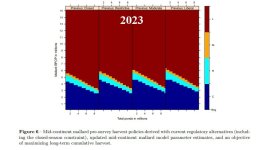All, thanks for the responses. Regarding those about harvest north vs. south, let's not forget the mid-continent mallard pop has been on a nine-year skid, down around 40%, and certainly correlates with lower harvest wherever you hunt in the Miss or central flyways. Like Rick I certainly hope this is the trough of a down cycle that will rebound, as opposed to a trend that will persist because of breeding habitat loss.
Hunter satisfaction is a curious thing and drives much of the discussions on various platforms we tune in to. On one hand we have the USF&WS applying science to manage populations and satisfy hunter expectations, on a stressed budget. On the other hand, you have the hunters, who I've come to the conclusion, cannot be satisfied. I got into a discussion on IG with a few that were really bashing AHM, and scoffing at science in general, blaming the folks that do that work based on their perception that hunting today sucks. It was PAINFULLY obvious their opinions were based solely on mistrust of anything coming from the government combined with complete ignorance of AHM (I won't waste my energy again with that sort of discussion

). There is no satisfying some folk.
But to my point. Waterfowlers in general have selective memory and that drives expectations, and especially dissatisfaction. Talk to hunters anywhere and they speak GLOWINGLY of hunting 10, 20, 30+ years ago. Ask them about today and you get bitching. If you could take a time machine back and talk to the same hunter, you'd hear bitching about the era now being praised as "glory days." Fess up. We all do it and get up in arms over perceived losses. You can't deny, memories are biased to recollect stellar days afield and forget empty sky days. Nobody admits to this bias but it's huge. I think another term in the dissatisfaction equation is ducks adapt faster than hunters. They change their tactics, but we hunt the same. Or perhaps what brought them to our area is no longer there, so they simply moved on, yet we expect success forever and a day.
One last thought as climb off my soap box. Had the removal of the 8.5 million goal happened during an up cycle, instead of looking like moderate or restricted seasons were in the near future, I think the USF&WS would not have given so much ammo for those that mistrust their every step and are being very vocal about it. Bad optics...







